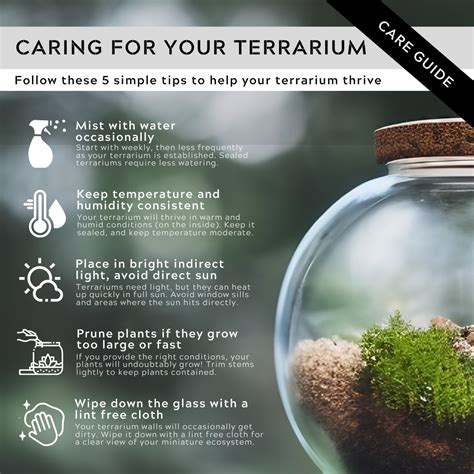Introduction

Terrariums, miniature ecosystems enclosed in glass containers, are a popular way to bring nature indoors. They offer a low-maintenance way to enjoy the beauty of plants, while also providing a habitat for small animals like insects or amphibians. However, even with their low-maintenance reputation, terrariums do require some basic care to keep them healthy. This guide will provide you with 4 essential steps to ensure your terrarium thrives for years to come.
1. Find the Right Location
The first step in terrarium maintenance is choosing the right location. Terrariums need bright, indirect light, so avoid placing them in direct sunlight or in dark corners. A good spot is near a window that receives plenty of natural light, but is not exposed to the sun’s harsh rays.
2. Water Wisely
Watering is crucial for terrarium maintenance. However, it’s important to water sparingly, as overwatering can lead to root rot. The best way to water a terrarium is to use a spray bottle to mist the plants and soil lightly. You should do this once or twice a week, or more often if the terrarium is in a warm, dry location.
3. Prune and Clean
Pruning and cleaning are also important aspects of terrarium maintenance. Dead leaves and stems should be removed regularly to prevent them from decomposing and attracting pests. Additionally, the glass walls of the terrarium should be cleaned occasionally to remove algae and debris.
4. Check for Pests
Pests can be a problem in terrariums, especially if there are live animals inside. Common pests include aphids, mealybugs, and spider mites. If you notice any pests, it’s important to treat them immediately to prevent them from damaging the plants. There are a number of natural pest control methods that can be used in terrariums, such as insecticidal soap or neem oil.
Additional Tips for Terrarium Maintenance
In addition to the 4 essential steps outlined above, there are a few additional tips that can help you keep your terrarium healthy and thriving:
- Use a well-draining potting mix to prevent waterlogging.
- Fertilize your plants every few months with a balanced liquid fertilizer.
- Avoid overcrowding the terrarium, as this can lead to competition for resources and increased risk of pests.
- If you have live animals in your terrarium, make sure to provide them with a suitable habitat and diet.
Conclusion
Terrariums are a great way to bring nature indoors, but they do require some basic maintenance to keep them healthy. By following the steps outlined in this guide, you can ensure that your terrarium thrives for years to come.
1. How often should I water my terrarium?
You should water your terrarium once or twice a week, or more often if the terrarium is in a warm, dry location.
2. What is the best way to water my terrarium?
The best way to water a terrarium is to use a spray bottle to mist the plants and soil lightly.
3. How often should I prune and clean my terrarium?
You should prune and clean your terrarium every few months, or more often if necessary.
4. What are some common pests that can affect terrariums?
Common pests that can affect terrariums include aphids, mealybugs, and spider mites.
5. What are some natural pest control methods that can be used in terrariums?
Some natural pest control methods that can be used in terrariums include insecticidal soap or neem oil.
6. What are some additional tips for terrarium maintenance?
Some additional tips for terrarium maintenance include using a well-draining potting mix, fertilizing your plants every few months, avoiding overcrowding the terrarium, and providing live animals with a suitable habitat and diet.





















